
The real reasons why sharks attack humans
- Published By Jane Njeri For The Statesman Digital
- 2 years ago
Shark attacks are still relatively rare occurrences even though humans should be easy prey compared to fast-moving fish and seals. But when they do happen, they can be devastating. So, why do sharks attack people?
The crystal-clear water beneath 13-year-old Hannah Mighall darkened for a moment. She was sitting astride her surfboard, enjoying the warmth of the sun as she and her cousin waited for the next wave in Tasmania’s idyllic Bay of Fires. Behind them the brilliant-white sandy beach was largely deserted and the surfing had been good so far.
The sudden shadow below made Mighall instinctively lift her feet – balls of kelp often broke off nearby rocks and drifted in the surf. “They are really slimy so I hated touching them,” she says.
But then something took hold of her leg.
The water around Mighall exploded as a five-metre-long great white shark latched onto her right leg
“It didn’t hurt at first, it was like something gently grabbed hold of me and then I was in the water,” says Mighall.
To those who witnessed what happened, however, it was anything but gentle. The water around Mighall exploded as a five-metre-long great white shark latched onto her right leg, lifted her off the surfboard and shook her in the air before disappearing underwater.
“It took a few seconds for me to realise it was a shark,” she says. “When I popped back up from the water I was lying on my back but my leg was in its mouth. All I could see was my black wetsuit leg, its teeth, pink gums, teeth and the dark bit under its nose where it meets white. I thought I was having a nightmare and kept trying to blink my eyes open.”
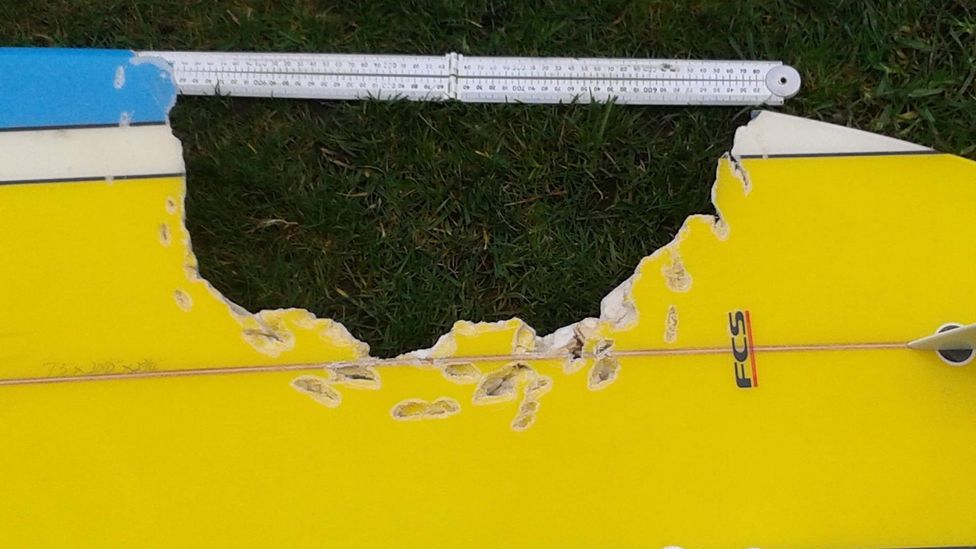
The shark that attacked Hannah Mighall took an enormous bite out of her surfboard before it allowed her to bob back to the surface (Credit: Malcolm Mighall)
Mighall’s cousin, 33-year-old Syb Mundy, who had been sitting on his own board just a few metres from her, raced over and began punching the shark in the side of its head. The shark pulled away from him and as it went underwater it let go of Mighall, lunging instead for her surfboard that was still attached by a rope to her leg.
With the board in its mouth, the shark pulled Mighall underwater for a second time. Moments later she popped back up to the surface with her damaged board. The animal had bitten clean through the fibreglass and foam.
Mundy grabbed hold of his cousin, put her on his back and paddled frantically for the shore. Earlier that day Mighall had been practicing water rescues with another girl during training with her local Surf Life Saving association, repeatedly being carried into shore as the “victim”. Now she was doing it for real.
The shark came with us all the way up to the beach – Hannah Mighall
“The shark was circling us underwater,” says Mighall. “Then this wave came in and Syb just said, ‘We have got to catch this as it is going to save our lives.’ I was just tapping the water as I was terrified but he was really paddling and the wave carried us to shore. The shark came with us all the way up to the beach as there is a deep gutter running up to it. We could see its fin as it surfed in on the same wave.”
Luckily for Mighall, among the few people on the beach who witnessed what had happened that day were a doctor and a nurse. They gave her vital first aid while waiting for an ambulance to arrive.
More than 10 years later, she still carries deep scars on her leg that trace the outline of the shark’s mouth. Her right leg is noticeably weaker than her left – so much so that she has to lift it with her hands when she wants to kick-start the dirt bike she rides occasionally.
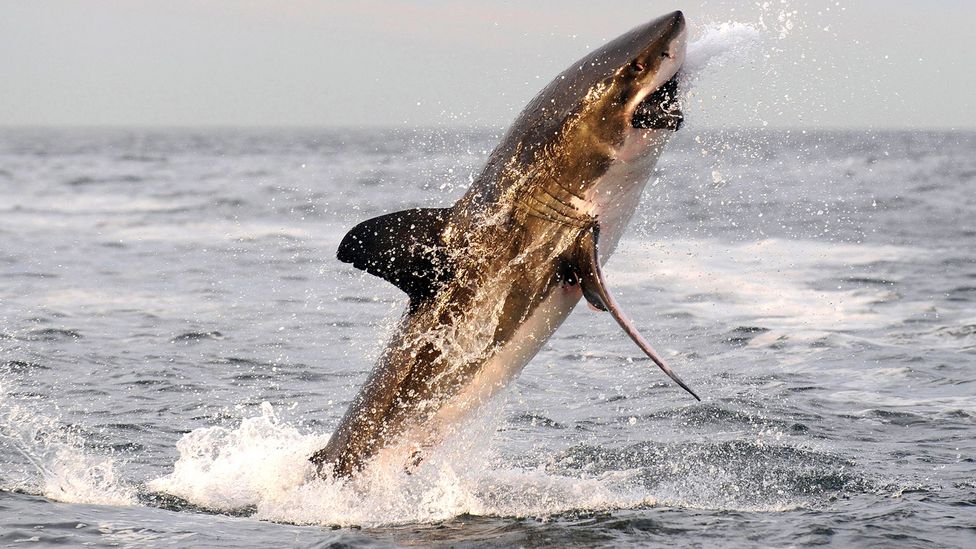
Great white sharks typically attack their prey from below with great speed, delivering a single devastating bite (Credit: Getty Images)
Mighall was one of roughly 83 people around the world to be attacked unprovoked by sharks in 2009. It is a figure that has remained around the same level over the past decade. The average number of unprovoked attacks between 2013-2017, for example, was 84. In 2022 there 57 unprovoked shark bites on humans and 32 provoked bites, according to the Florida Museum of Natural History’s International Shark Attack File. Nine of these attacks where fatal, with five considered to be unprovoked.
But recent research indicates that shark attacks in some parts of the world appear to be on the rise. The eastern US and southern Australia have seen shark attack rates almost double in the past 20 years, while Hawaii has also seen a sharp increase. But why?
“Shark bites are strongly correlated to the number of people and number of sharks in the water at the same time,” says Gavin Naylor, director of the Florida Program for Shark Research, which maintains the International Shark Attack File. “The more sharks and people there are in one place, the greater the chance of them bumping into each other.”
This seems like an obvious point, but when you look closer at where attacks are taking place there are some clues as to what might be going on. The large human populations along the southern coast of Australia and the eastern coast of the US mean large numbers of people enjoying the water. But southern Australia has also seen rising numbers of fur seals along its coastline, the favourite prey of great white sharks in the region.
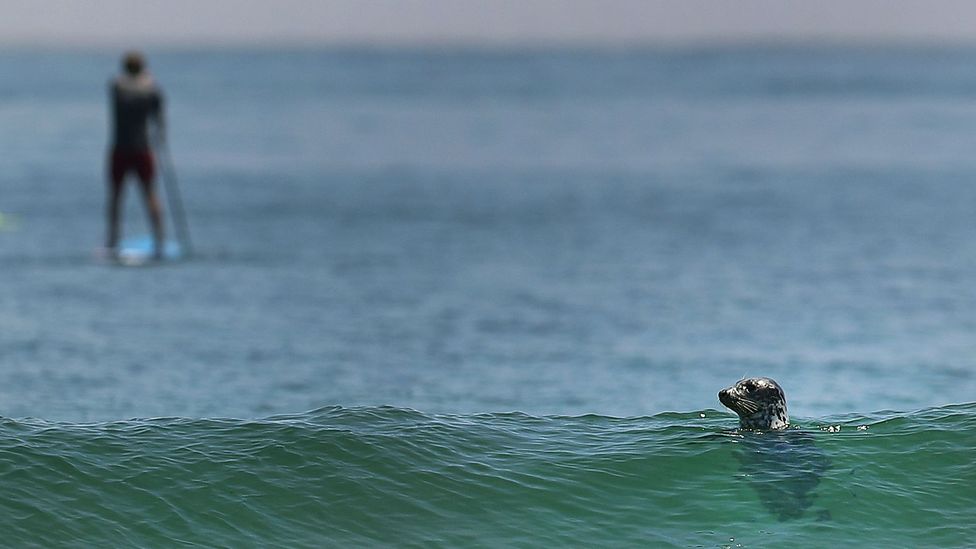
The resurgence in seal populations on Cape Cod on the east coast of the US has led to rising numbers of great white sharks in areas popular with people (Credit: Getty Images)
Similarly, seal populations off Cape Cod on the coast of Massachusetts in the US have rebounded in recent years, largely thanks to protection by the US’s Marine Mammal Act introduced in 1972. This has led to increased numbers of great whites in the area too during the warm summer months as they look to feast on the seals that pull themselves out to bask on the beaches.
Sadly, last autumn, Massachusetts suffered its first fatal shark attack in 82 years and growing numbers of shark sightings have led to a string of beach closures.
We are like helpless little sausages floating around in the water – Gavin Naylor
But there is no real evidence that sharks are actively hunting humans, according to the scientists who study them. Great whites in the North Atlantic, for example, show seasonal movement patterns, migrating thousands of miles to warmer waters further south during the winter months. Some mature adults will venture out into the open ocean for months at a time, covering tens of thousands of miles and diving to depths of 1,000m (3,280ft) as they seek prey.
“We are like helpless little sausages floating around in the water,” says Naylor. But despite being potentially such an easy meal, sharks are really not that interested in hunting humans. “They generally just ignore people. I think if people knew how frequently they were in water with sharks, they would probably be surprised.”
However, Naylor believes that the official statistics on shark attacks are probably an underestimate. Most reports come from highly developed countries with large populations and highly active news media. Attacks on remote islands or in less developed communities probably go unreported.
Looking deeper at the statistics for the number of shark attacks can reveal some fascinating trends. In 2018, there were just 66 confirmed, unprovoked attacks, roughly a 20% fall compared to previous years. Just four of these were fatal according to the International Shark Attack File, although another database of shark attacks records seven deaths.
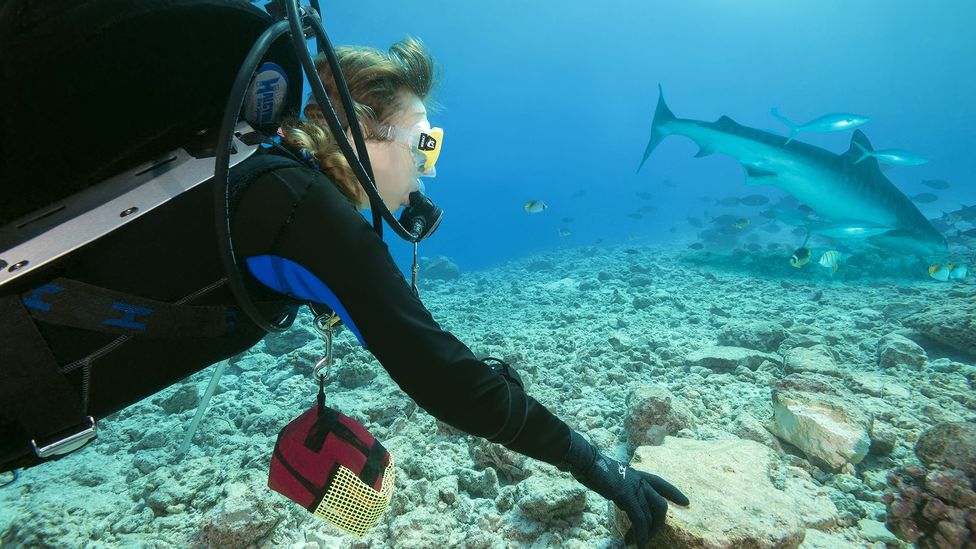
Tiger sharks are one of the three main species responsible for attacks on humans but much of the time they ignore people in the ocean (Credit: Getty Images)
The reason for the fall in attacks – which bucks the overall trend of growing numbers of attacks – has been attributed to a sharp decline in the number of black-tipped sharks. These sharks account for many of the bites around the south-eastern US, migrating down the coast of Florida due to rising sea temperatures that have led their prey to become more dispersed.
For decades Florida has seen the most number of shark bites globally. The 16 cases it saw in 2022 represented 39% of the US total and 28% of all unprovoked bites worldwide.
The findings highlight one of the key challenges in understanding why sharks bite humans. There are dozens of different species responsible for bites, each with their own unique behaviour, hunting strategies, prey and preferred habitat – although in many cases the species can be misidentified or not identified at all.
The majority of unprovoked attacks on humans where a species is identified involve three large culprits: the great white, tiger and bull sharks. Yet great whites – the species depicted in the film Jaws and demonised by Hollywood ever since – isn’t just a separate species, but an entirely different taxonomic order from the other two.
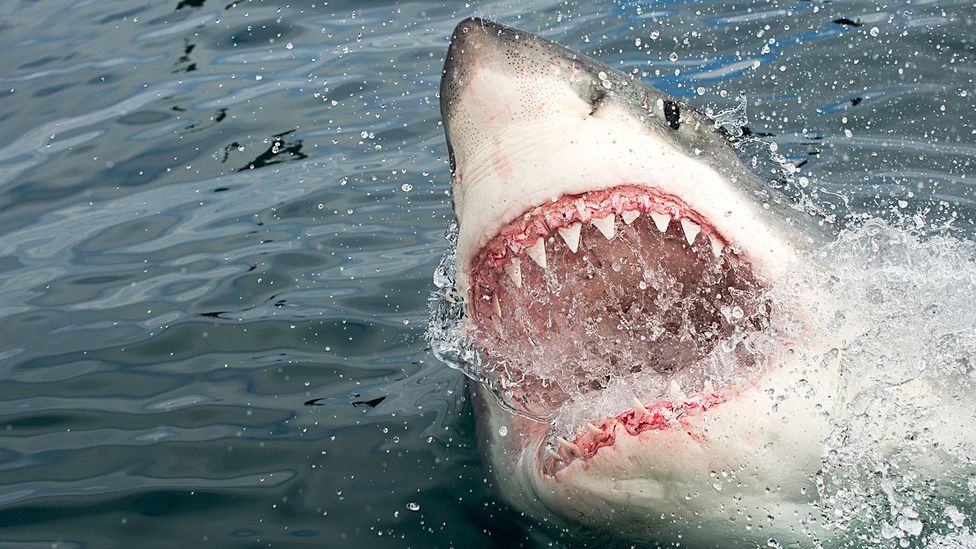
Great white sharks are considered to be the most dangerous species in the oceans today, but we still know very little about their life cycle and behaviour (Credit: Getty Images)
“There are 530 different species of shark and there is so much diversity among them. You can’t just group them together,” says Blake Chapman, a marine biologist who has studied shark sensory systems and recently wrote a book on shark attacks on humans. “Different species have such a range in terms of their sensory biology, how they behave, their motivations and the habitats they live in.”
Bull sharks, for example, tend to hunt in shallow, murky water that will require them to rely less on vision and more upon their sense of smell and electroreception, which allows them to detect minute electrical fields produced by their prey.
There is some evidence that shark teeth may also function as mechanosensory structures to help the animals learn more about what they are biting
“(Great) white sharks, which often hunt in very clear water use their vision a lot more and their eyesight is much better,” says Chapman. There is also some evidence that shark teeth may also function as mechanosensory structures – similar to touch – to help the animals learn more about what they are biting.
Chapman believes there may be a complex set of reasons for why unprovoked attacks on humans appear to have risen in recent decades.
Aside from rising human populations along coastlines, the destruction of habitat, changing water quality, climate change and shifts in prey distribution are leading sharks to gather in greater numbers at certain hotspots around the world.
In 1992, for example, there was a sudden spate of shark bites off the coast of Recife, Brazil – an area that had no unprovoked attacks for the entire previous decade. Chapman believes that heavy commercial port construction in the area damaged large areas of reef and mangrove, potentially displacing species like bull sharks, which moved to new areas like Recife in search of prey.
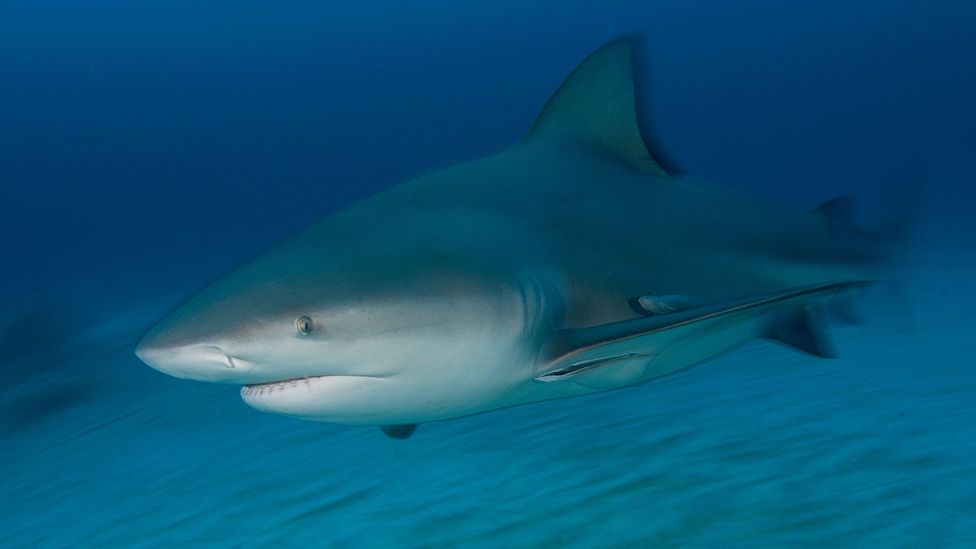
Bull sharks are aggressive animals that typically hunt in water with reduced visability (Credit: Getty Images)
Réunion Island in the Indian Ocean – renowned for its beautiful, unspoiled marine habitats – has seen a dramatic rise in tourism but in recent years it has also suffered a growing number of shark attacks by the bull and tiger sharks that live in the surrounding waters. Since 2011, there have been 11 fatal attacks on Reunion, mainly on surfers. Those who survive often lose limbs. Researchers have found that around two-thirds of the Reunion attacks have occurred in turbid water and swells of more than two metres – the favoured environment for bull sharks, which are thought to be responsible for most of the attacks.
Naylor believes that in most cases, sharks bites are a case of mistaken identity.
“If these animals are chasing bait fish, the flash of the white sole of a foot from someone kicking on a board might cause them to dart at it,” he says. “When you have a large animal like a tiger or a white shark, which move quickly, a bite is far more likely to be fatal.”
Great whites typically attack from below, delivering a massive catastrophic bite. In some cases they will withdraw while their prey bleeds to death before returning to eat.
“A great white in full predatory mode is quite a sight,” says Greg Skomal, a marine biologist with the Massachusetts Division of Marine Fisheries who has been tagging and tracking great white sharks since 2009. He should know – last year, as he was leaning over the pulpit on the bow of a research vessel while trying to tag a shark, a large great white breached directly underneath him with its jaws agape.
“It gave me some idea of what a seal feels like,” he says. “I’ve seen that behaviour a couple of times over the years we have been doing this. Most of the time we put a camera in the water and the sharks are completely complacent. We must have done it thousands of times. But on a handful of occasions they attack straight away, breaking the pole and the camera. It is like they are in a heightened predatory state where their senses lock onto any kind of stimuli.
“I wonder if those strikes on people that are not merely investigative are the result of a person being in the wrong place at the wrong time with a shark in this kind of heightened state.”
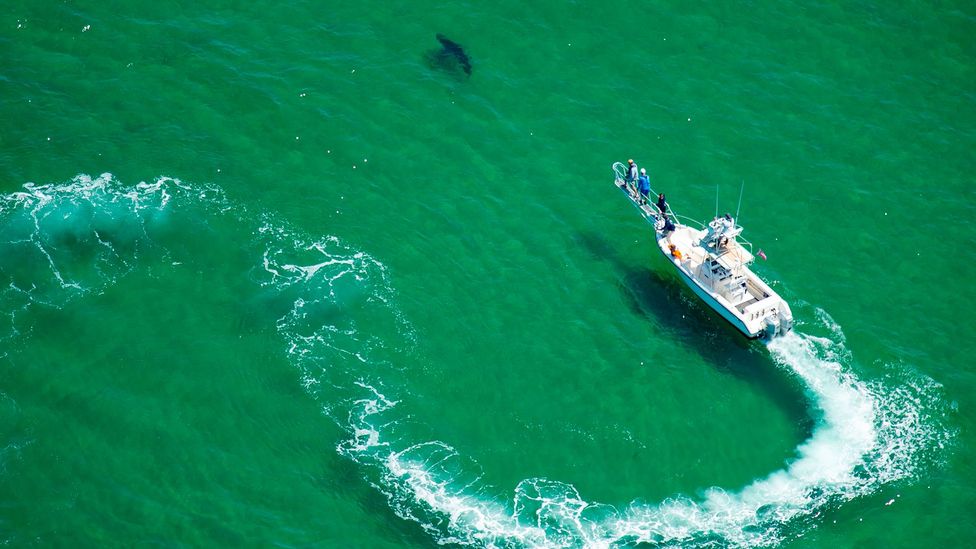
Efforts to tag great white sharks is starting to provide insights into the behaviour and life cycles of these enormous predators (Credit: Getty Images)
But for every attack on a person, there are just as many stories of people who have managed to get up close to these giant predators without any harm. Take Ocean Ramsey for example, who swam alongside an enormous 20-feet-long great white off the coast of Hawaii and made headlines around the world.
Skomal and his colleagues are now using new high-resolution tags that can give the researchers minute by minute and second by second data on what the sharks are doing.
It is like they are in a heightened predatory state where their senses lock onto any kind of stimuli – Greg Skomal
He hopes it might help to answer questions about the behaviour of these animals as well as about where and how they breed. It could, ultimately, also help to tell us something about the reasons underlying attacks on humans, he says.
Some researchers are turning to forensic methods to try and unravel some of the reasons behind attacks. They are developing techniques to use DNA and bite-mark patterns to identify species, while others are examining video footage of attacks and comparing these to injuries to get a better understanding of what happened.
Data from shark spotters in South Africa have shown that great whites are more active near the surface, and so more likely to be seen, when water temperatures are above 14C, during a new moon and in the afternoon. Other research, however, has suggested that great whites are more successful hunters at night when there is a full moon.
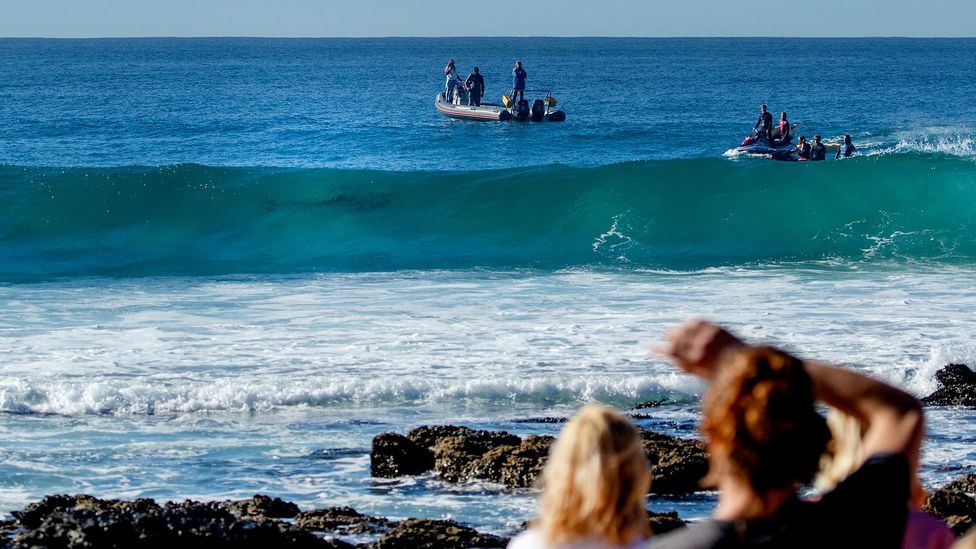
Many areas now operate shark patrols to spot sharks before they enter areas used by swimmers and surfers so they can be alerted (Credit: Getty Images)
Other researchers have suggested juvenile great whites may attack humans as they hone their predatory skills, in much the same way that young lions will experiment with whatever prey they can take on.
But regardless of the reasons for attacks on humans, the risks involved are still vanishingly small. In Australia the rate of shark attacks is in the order of 0.5 attacks per million people, while in the US it is less than 0.2 attacks per million. It is worth noting that in 2018, the US figures dropped to around 0.08 attacks per million while in Australia they rose to 0.8 attacks per million people.
In Australia the rate of shark attacks is in the order of 0.5 attacks per million people, while in the US it is less than 0.2 attacks per million
These figures are blunt instruments, of course. They fail to account for the comparatively fewer numbers of people who actually use the water, and the fewer still who swim in water inhabited by dangerous sharks. But these statistics, however ridiculous or comforting they might seem, do little to dampen our fear of sharks.
“Fear has played a very important role in our evolution,” adds Chapman. “Humans don’t need to be eaten themselves by a sabre tooth tiger to learn to fear them. We learn that fear very quickly from a single story. People who have never seen a shark before fear them because we hear or watch stories about them.”
The focus on the risks that sharks pose to us also diverts attention from the far greater threat we pose to their survival due to over fishing and human-induced climate change. Some estimates suggest shark numbers in Australian waters, for example, have declined by between 75-92%.
But for those who are afraid and want to know how to protect themselves from a shark, some advise punching a biting shark in the gills or poking it in the eyes. Swimming in groups and staying close to the shore are known to reduce the risk of attacks. Wearing dark clothing and avoiding wearing jewellery can also help to reduce the chance of attracting a shark’s attention in the first place.
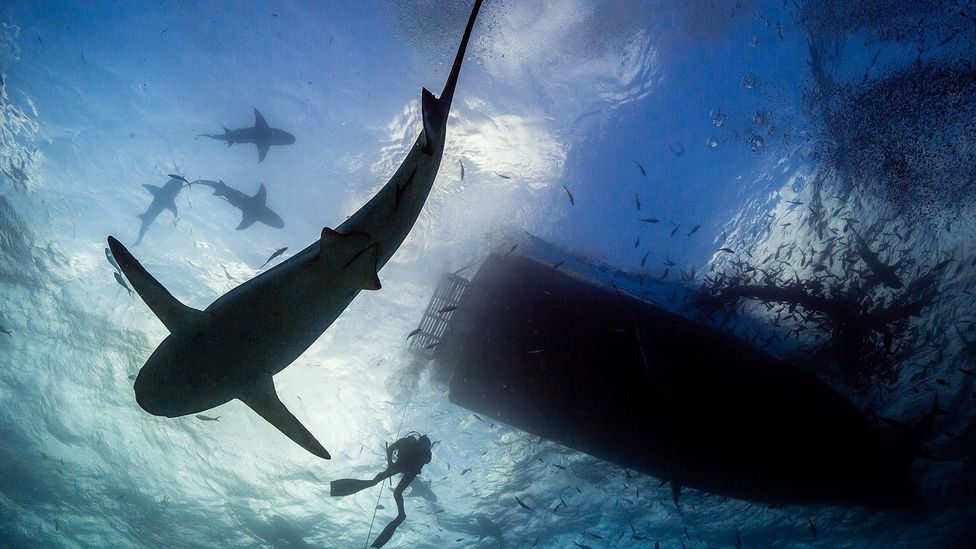
Getting into water where there are lots of bait fish that can attract sharks will increase your risk of being bitten (Credit: Alamy)
There are also a number of shark deterrents on the market that use electrical or electromagnetic pulses to interfere with the animals’ senses, but these have mixed results, according to research. (Read more about whether technology could reduce shark attacks).
In some areas, the local authorities themselves have taken action. Traditionally, some authorities have used shark nets to protect areas used by swimmers, but these are controversial due to the harm they do to other wildlife.
Instead, smart drum lines – which use baited hooks attached to a system that sends out an alert when triggered – are now being trialled at several beach locations along the coast of western Australia. When a shark takes the bait, an alert is sent to response teams who catch, tag and then release the shark in a safer location.
The harm caused by shark attacks can extend far beyond their immediate victims
Another approach being tested in Cape Town, South Africa, is an electromagnetic cable that aims to discourage sharks from approaching areas used by swimmers. Scientists have also been testing an electromagnetic barrier as an alternative to shark nets.
These could be important steps as the harm caused by shark attacks can extend far beyond their immediate victims.
“Shark attacks cause a lot of personal loss, but the impact they can have on the wider community is often not considered,” says Dave Pearson, one of the founders of Bite Club, which offers support to the survivors of shark attacks. He himself was attacked by a bull shark while surfing eight years ago in south-west Australia, nearly losing his arm when the animal smashed into him, bit into his forearm to the bone and carried him underwater.
“After my attack, lots of my friends didn’t go back into the water for a long time,” he says. “The fear spreads really quickly.”

A spate of shark attacks on Reunion Island led to calls for the local authorities to take action beyond bans on swimming and surfing (Credit: Getty Images)
On a recent visit to Ballina, a surfing hotspot in New South Wales, Australia, Pearson saw just what a shark attack can do to a town. The area has suffered a spate of attacks, including two fatal ones on surfers in 2015.
“I was standing there watching these perfect waves coming in but there was not one person in the water,” he says. “One of the local coffee shops said they had suffered an 85% drop in business and the surf shop couldn’t give boards away. They were both thinking about closing.”
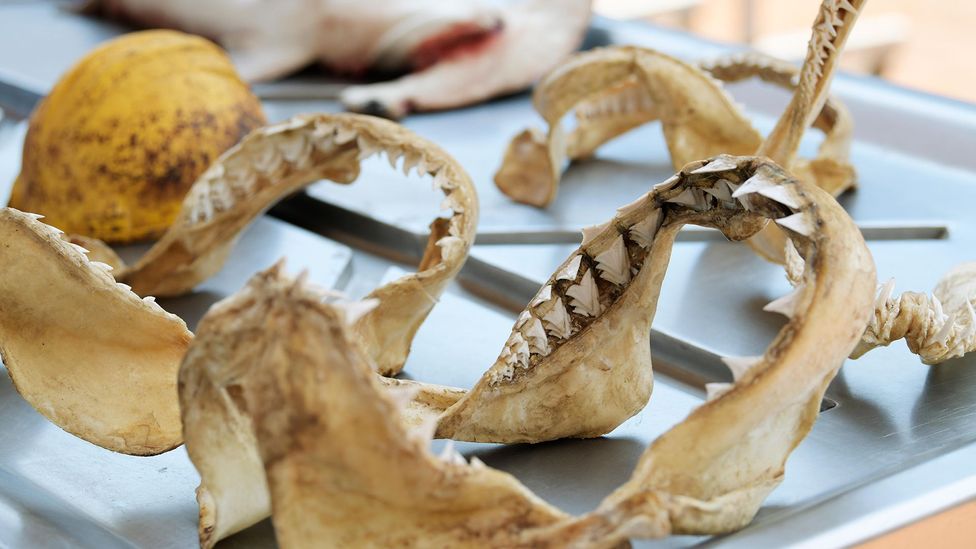
Forensic analysis of shark bite patterns is helping to reveal more about the species responsible for attacks and the reasons why they happen (Credit: Alamy)
A similar story is unfolding in Reunion where the local authorities have banned surfing and swimming in the water at certain times of the year due to fears about further shark attacks. The number of bites on humans have reduced as a result, but it has also taken its toll on the tourism industry.
Despite the fear and economic costs of shark attacks, like many of those who survive encounters with sharks, Hannah Mighall doesn’t want to see these animals being punished with culls or by killing those animals that stray into areas being used by humans.
The personal effect of her attack, however, has been long lasting. While she got back onto a surfboard within six months of her attack and went “shark mad”, plastering her bedroom walls with pictures of the animals, she says her passion for surfing gradually ebbed away.
“I’d be fine and then I’d get this weird feeling and start looking around,” she explains. “I never had that before – I was a water baby and loved the water. Now I am scared of it. I used to think sharks were cool, but now I am terrified of them, although I still [have] respect for them.”
Her shark posters have gone, as has her enjoyment of the sea. Instead she tends to prefer swimming or kayaking on rivers. But she still has the occasional nightmare about sharks.
Pearson says this is a common problem in shark attack victims.
“Many of them never fully recover and the psychological scars can be even greater than the physical ones,” he says. “I started getting dreams and would wake up screaming at night. I ended up seeing a psychiatrist to help me get over this.”
Mighall still has the surfboard she was riding on the day of her attack, a huge toothy bite missing from one side. Like the scars on her leg, it is a reminder of what can happen on the rare occasions that sharks do choose to attack the humans who stray into their domain.
They both entitle her to fear these animals. For those who fear them without having had such a close encounter she has a sound piece of advice.
“If you are frightened, you can always stay out of the water.”
* This article was originally published on 9 August 2019. It has been updated with data from 2022.
Share on
Tags
SHARE YOUR COMMENT
MORE STORIES FOR YOU
Trending Stories
DJ Mo’s former illicit lo...
- Published By Jane
- January 15, 2024
Mapenzi! Zari and Tanasha...
- Published By Jane
- October 24, 2023
Zuchu Speaks on Diamond P...
- Published By Jane
- October 12, 2023
Hio Ni Upumbavu Wasituche...
- Published By Jane
- November 8, 2023
RECOMMENDED FOR YOU
How People are Using AI t...
- Published By The
- October 29, 2025
How Raila Odinga’s Death...
- Published By The
- October 29, 2025
What is Ayurveda? Raila O...
- Published By The
- October 29, 2025
Why Parents Should Spend...
- Published By The
- October 29, 2025
Latest Stories
Tesla Says Elon Musk Shou...
- Published By The
- November 5, 2025
Equity Group and iamtheCO...
- Published By Jedida
- November 5, 2025
Regina Daniels Opens Up o...
- Published By The
- November 5, 2025
Diamond And Zuchu Prays F...
- Published By The
- November 5, 2025



